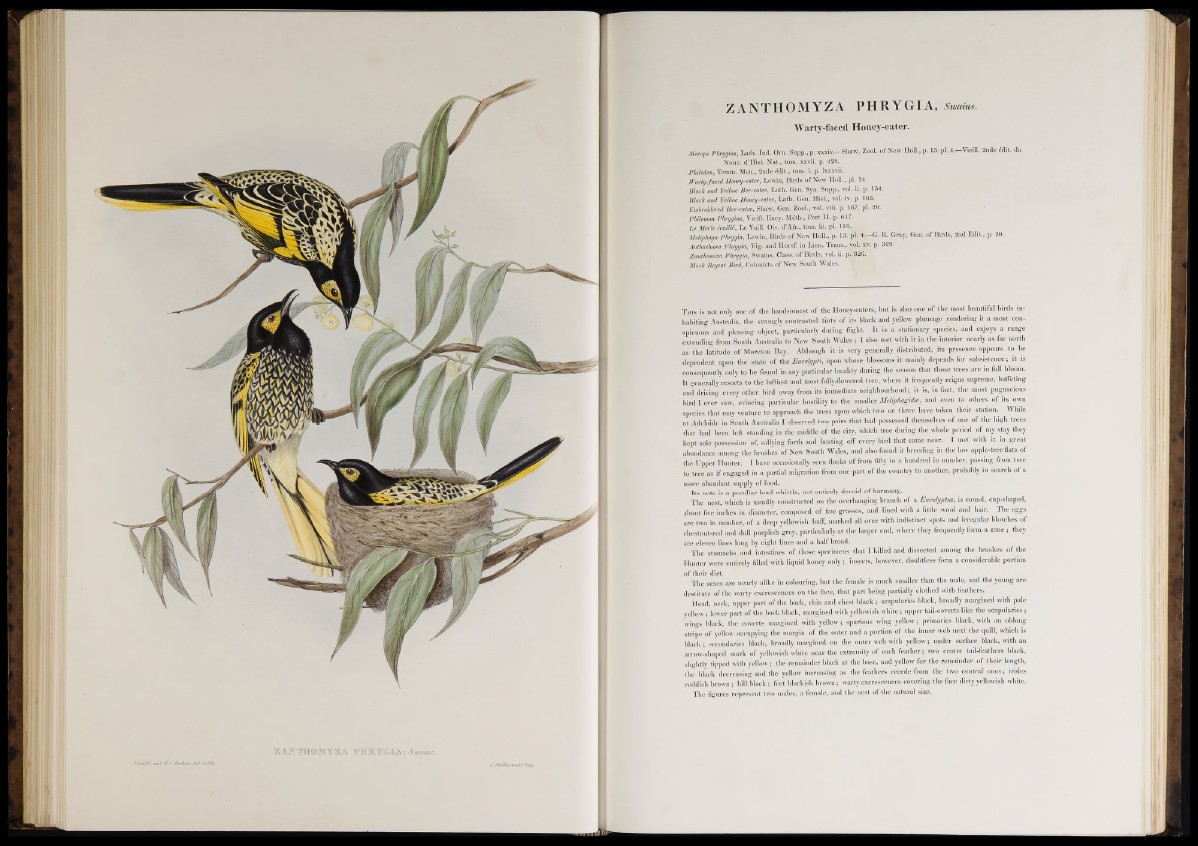
M l E O M Y S A f f l l ï l t t : S wccuus.
ZANTHÖMYZA PHRYGIA, ä™ .
Warty-faced Honey-eater.
Merope Pkrygim, Lath. Ind. Om. Supp.,p. xxxiv.-Shaw, Zool. of New HoU., p. 13. pi. 4.—VieUl. 2nde édit. du
Nouv. d’Hist. Nat., tom. xxvii. p. 428.
Phileim, Temm. Men., 2nde édit., tom. i. p. lxxxvii.
Warty-faced Honey-eater, Lewin, Birds of New Holl., pi. 14.
Black and Yellow Bee-eater, Lath. Gen. Syn. Supp., t o I. ii, p. 154.
Black and Yellow Honey-eater, Lath. Gen. Hist, vol. iv. p. 165,
Embroidered Bee-eater, Shaw, Gen. Zool., vol. viii. p. 167. pi. 20.
Philemon Phrygius, Vieill. Ency. Méth., Part II. p. 617.
Le Merle écaillé, Le Vaill. Ois. d’Afr., tom. iii. pi. 116,
Meliphaga Phrygia, Lewin, Birds of New Hojigp. H p l- 4 .-G . R. Gray, Gen. of Birds, 2nd Edit., p. 20.
Anthodusra Phrygia, Vig. and Horsf. in Linn. Trans., vol. xv. p. 322.
Zanthomiza Phrygia, Swains. Class, of Birds, vol. ii. p. 326.
Mock Regent Bird, Colonists of New South Wales. :
T h is is not only one of the handsomest of the Honey-eaters, but is also one of the most beautiful birds inhabiting
Australia, the strongly contrasted tints o f its black and yellow plumage rendering it a most conspicuous
and pleasing object, particularly during Sight. It is a stationary species,, and enjoys a range
extending from South Australia to New South Wales ; I also met with it in the interior nearly as far north
the latitude of Moreton Bay. Although it is very generaUy distributed, its presence appears to be
dependent upon the state of the Eucalypti, upon whose blossoms it mainly depends for subsistence; it is
consequently only to be found in any particular locality during the season that those trees are in full bloom.
It generally resorts to the loftiest and most fully-flowered tree, where it frequently reigns supreme, buffeting
and driving every other bird away from its immediate neighbourhood; it is, in fact, the most pugnacious
bird I ever saw, evincing particular hostility to the smaller MeliplagiAe, and even to others of its own
species that may venture to approach the trees upon which two or three have taken their station. While
at Adelaide in South Australia I observed two pairs that had possessed themselves of one o f the high trees
that had been left standing in the middle of the city, which tree during the whole period of my stay they
kept sole possession of, sallying forth and beating off every bird that came near. I met with it in great
abundance among the brushes o f New South Wales, and also found it breeding in the low apple-tree flats of
the Upper Hunter. I have occasionally seen Socks of from Sfty to a hundred in number, passing from tree
to tree as if engaged in a partial migration from one part of the country to another, probably in search of a
more abundant supply of food.
Its note is a peculiar loud whistle, not entirely devoid o f harmony.
The nest, which is usually constructed on the overhanging branch of a Eucalyptus, is round, cup-shaped,
about Sve inches in diameter, composed of fine grasses, and lined with a little wool apd hair. The eggs
are two in number, of a deep yellowish buff, marked all over with indistinct spots and iijregular blotches o f
chestnut-red and dull purplish grey, particularly at the larger end, where they frequently form a zone; they
are eleven lines long by eight lines and a half broad.
The stomachs and intestines of those specimens that I killed and dissected among the brushes o f the
Hunter were entirely filled with liquid honey only; insects, however, doubtless form a considerable portion
of their diet.
The sexes are nearly alike in colouring, but the female is much smaller than the male, and the young are
destitute of the warty excrescences on the face, that part being partially clothed with feathers.
Head, neck, upper part o f the back, chin and chest black; scapularies black, broadly margined with pale
yellow; lower part o f the back black, margined with yellowish white; upper tail-coverts like the scapularies;
wings black, the coverts margined with yellow; spurious wing yellow; primaries black, with an oblong
stripe of yellow occupying the margin of the outer and a portion of the inner web next the quill, which is
black ; secondaries black, broadly margined on the outer web with yellow; under surface black, with an
arrow-shaped mark of yellowish white near the extremity of each feather; two centre tail-feathers black,
slightly tipped with yellow; the remainder black at the base, and yellow for the remainder o f their length,
the black decreasing and the yellow increasing as the feathers recede from the two central ones; irides
reddish brown; bill black; feet blackish brown; warty excrescences covering the face dirty yellowish white.
The figures represent two males, a female, and the nest of the natural size.